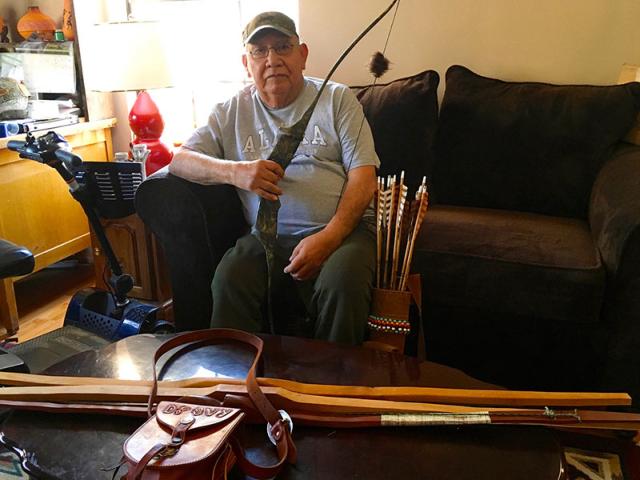 |
Canku Ota
|
 |
|
(Many Paths)
|
||
|
An Online Newsletter
Celebrating Native America
|
||
|
February 2017 - Volume
15 Number 2
|
||
|
|
||
|
Standingwater Passes
On Archery Knowledge
|
||
|
by Lindsey Bark - Staff
Writer Cherokee Phoenix
|
||
Locust Grove, OK – Since he was 8 years old, Cherokee Nation citizen Dave Standingwater has had an interest in archery and been fascinated by the flight of the arrow. Growing up in the Snake Creek Community near Locust Grove, Standingwater learned about hunting from his grandmother, Maggie Whitekiller Standingwater. His first hunting experience was at age 13, killing a deer with
a bow and arrow his uncle made. He said when times were hard and his father was unemployed, he helped out by hunting and providing for his family. "It was rough times back then," he said. Years later, he became a nationally ranked archer in the Cabela's Archery Shooters Association, competing across the United States and in national championship tournaments. In 1991, he experienced his first archery outing when his son invited him to a 3-D archery range in Locust Grove. Though he hunted growing up, shooting 3-D targets proved a challenge. "My first outing was terrible. I was so bad, and so I asked them if they (archery range) was open every weekend. So I went back. I started shooting and practicing," Standingwater said. He said he practiced at home for 20 minutes to 30 minutes a day, eventually entering local archery tournaments. "I got to taking first, second and third place trophies and stuff like that," he said. In 1994, he joined the Cabela's Archery Shooters Association tour and his first tournament was in Oklahoma City. He began competing in out-of-state tournaments and racked up points to qualify for the championship tournament in Tennessee. "At that particular tournament, there were like 2,500 actual shooters, and I shot the traditional way – stick and string," he said. He used a custom-made modern dual-purpose Black Widow bow. He said competing nationally enhanced his archery skills against many high-level shooters. "If you missed, your arrow was just gone. But in competition like that you didn't miss, you just didn't miss, he said." He competed until 2001. He never won a championship tournament but often placed second and third. One of the biggest highlights of his career was when a Cabela's magazine recognized him as one of the top 10 traditional bow shooters in the nation during the 1999 tour. "I started looking down that list there and my name was No. 7. I wore that magazine out showing people," Standingwater said. "I just wanted to shoot. I never thought that I'd become in the top 10 bracket." Now at 74, Standingwater continues his passion for shooting, bow making and learning how to flint knap. He made his first bow out of bois d'arc, learned how to cut a stave (a trimmed rod of wood used to make a bow) and make bowstring from squirrel hide. He studies to become a more "powerful" and "faster" bow shooter and said he is staying with the traditional way of shooting so that he has the knowledge to survive and provide for his family if he needs to. "I'm a full traditional shooter. I don't aim down the arrow. I don't look at the string. I look at the place where I want to hit. That's where I want the arrow to go and that's what I'm looking at. So that's as traditional as you can get. I think that's a plus when you get out in the woods. A lot of times your shots are going to be quick," he said. He said he's passing his archery knowledge to his family and compared his great-niece's shooting to that of Robin Hood. He said the two often take nature walks and practice shooting rabbits and squirrels. Standingwater said he's retained what he learned from his grandmother, who was a midwife and knew how to gather plants for medicines. Through her, he also learned to fish and gather foods that are in season. "I learned a lot from my grandmother, (she) taught me a lot."
|
||
|
|
|
|
||
|
|
||
| Canku Ota is a free Newsletter celebrating Native America, its traditions and accomplishments . We do not provide subscriber or visitor names to anyone. Some articles presented in Canku Ota may contain copyright material. We have received appropriate permissions for republishing any articles. Material appearing here is distributed without profit or monetary gain to those who have expressed an interest. This is in accordance with Title 17 U.S.C. Section 107. | ||
|
Canku Ota is a copyright ©
2000 - 2017 of Vicki Williams Barry and Paul Barry.
|
||
 |
 |
|
|
The "Canku
Ota - A Newsletter Celebrating Native America" web site and
its design is the
|
||
|
Copyright ©
1999 - 2017 of Paul C. Barry.
|
||
|
All Rights Reserved.
|
||
